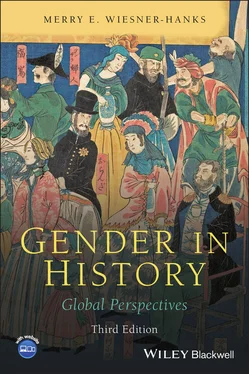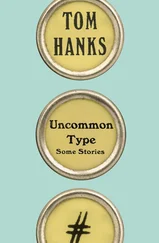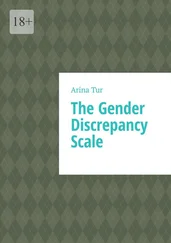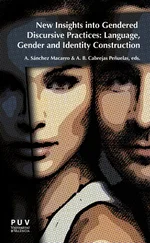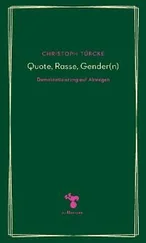It is hard to know where to begin with suggestions, for the amount of materials is vast, and the works mentioned in the Further Reading for every chapter all contain information about ideas and norms.
Analyses of ideas in Asia include Lisa Raphals, Sharing the Light: Representations of Women and Virtue in Early China (Albany, NY: State University Press of New York, 1998); Charlotte Furth, A Flourishing Yin: Gender in China’s Medical History, 960–1665 (Berkeley, CA: University of California Press, 1999); Mandakranta Bose, ed., Faces of the Feminine in Ancient, Medieval, and Modern India (New York: Oxford University Press, 2000); Zainab Bahrani, Women of Babylon: Gender and Representation in Mesopotamia (New York: Routledge, 2001); Susan Brownell and Jeffrey N. Wasserstrom, eds., Chinese Femininities, Chinese Masculinities: A Reader (Berkeley, CA: University of California Press, 2002); Helen Creese, Women of the Kakawin World: Marriage and Sexuality in the Indic Courts of Java and Bali (Armonk, NY: M. E. Sharpe, 2004); Dorothy Ko, Cinderella’s Sisters: A Revisionist History of Footbinding (Berkeley, CA: University of California Press, 2005); Miyako Inoue, Vicarious Language: Gender and Linguistic Modernity in Japan (Berkeley, CA: University of California Press, 2006).
On ideas in Europe, see: Constance Jordan, Renaissance Feminism: Literary Texts and Political Models (Ithaca, NY: Cornell University Press, 1990); Elaine Fantham et al., Women in the Classical World: Image and Text (New York: Oxford University Press, 1994); Victoria Lorée Enders and Pamela Beth Radcliff, eds., Constructing Spanish Womanhood: Female Identity in Modern Spain (Syracuse, NY: State University of New York Press, 1999); Thelma S. Fenster and Clare A. Lees, eds., Gender in Debate from the Early Middle Ages to the Renaissance (New York: Palgrave, 2002); Ulrike Gleixner and Marion Gray, eds., Gender in Transition: Discourse and Practice in German - Speaking Europe, 1750–1830 (Ann Arbor, MI: University of Michigan, 2006).
On Latin America, see Lowell S. Gustafson and Amelia M. Trevelyan, eds., Ancient Maya Gender Identity and Relations (Westport, CT: Bergin and Garvey, 2002); Sylvia Chant with Nikki Craske, Gender in Latin America (New Brunswick, NJ: Rutgers University Press, 2003); Erin O’Connor, Mothers Making Latin America: Gender, Households, and Politics since 1825 (Malden, MA: Wiley Blackwell, 2014).
On Africa, see Karen Armstrong, Shifting Ground and Cultural Bodies: Postcolonial Gender Relations in Africa and India (New York: University Press of America, 1999); Dorothy L. Hodgson and Sheryl A. McCurdy, eds., “Wicked” Women and the Reconfiguration of Gender in Africa (Portsmouth, NH: Heinemann, 2001); Wendy Woodward, Patricia Hayes, and Gary Minkley, eds., Deep hiStories: Gender and Colonialism in Southern Africa (New York: Rodopi, 2002). Interesting comments on recent changes in gender norms globally are provided in Sylvia Chant and Cathy McIlwaine, Three Generations, Two Genders, One World: Women and Men in a Changing Century (London: Zed Books, 1998).
Works that look at law as well as ideas include Mary Ann Glendon, The Transformation of Family Law: State, Law, and Family in the United States and Western Europe (Chicago, IL: University of Chicago Press, 1989); Thomas Kuehn, Law, Family, and Women: Toward a Legal Anthropology of Renaissance Italy (Chicago, IL: University of Chicago Press, 1992); Erin P. Moore, Gender, Law, and Resistance in India (Tucson, AZ: University of Arizona Press, 1998); Tim Stretton, Women Waging Law in Elizabethan England (Cambridge: Cambridge University Press, 1998); Srimati Basu, She Comes to Take Her Rights: Indian Women, Property, and Propriety (Albany, NY: State University of New York Press, 1999); Kimberly Gauderman, Women’s Lives in Colonial Quito: Gender, Law, and Economy in Spanish America (Austin, TX: University of Texas Press, 2003); Amira El-Azhary Sonbol, Women of Jordan: Islam, Labor, and the Law (Syracuse, NY: Syracuse University Press, 2003); Elisabeth Meier Tetlow, Women, Crime and Punishment in Ancient Law and Society: The Ancient Near East (New York: Continuum International, 2004); Judith Tucker, Women, Family and Gender in Islamic Law (Cambridge, UK: Cambridge University Press, 2008); Sara L. Kimble and Marion Röwekamp, eds., New Perspectives of European Women’s Legal History (London: Routledge, 2016); Xiaoping Cong, Marriage, Law and Gender in Revolutionary China, 1940–1960 (Cambridge, UK: Cambridge University Press, 2018); Ilan Peled, Law and Gender in the Ancient Near East and the Hebrew Bible (London: Routledge, 2019).
Sherry Ortner’s essay about nature and culture has been reprinted in her The Politics and Erotics of Culture (Boston, MA: Beacon Press, 1996). Further discussions about the links between gender and nature include Carolyn Merchant, The Death of Nature: Women, Ecology and the Scientific Revolution (New York: Harper & Row, 1980) and Ecological Revolutions: Nature, Gender, and Science in New England (2nd edn., Chapel Hill, NC: University of North Carolina Press, 2010); Londa Schiebinger, Nature’s Body: Gender in the Making of Modern Science (Boston, MA: Beacon Press, 1993); Vera Norwood, Made from This Earth: American Women and Nature (Chapel Hill, NC: University of North Carolina Press, 1995); Virginia Scharff, ed., Seeing Nature through Gender (Lawrence, KS: University Press of Kansas, 2003); Douglas A. Vacoch, ed., Transecology: Transgender Perspectives on Environment and Nature (London: Routledge, 2020).
More general analyses of the role of gender in science historically include Thomas Laqueur, Making Sex: Body and Gender from the Greeks to Freud (Cambridge, MA: Harvard University Press, 1990); David Noble, A World without Women: The Clerical Culture of Western Science (New York: Knopf, 1992); Joan Cadden, Meanings of Sex Differences in the Middle Ages: Medicine, Science, and Culture (Cambridge, UK: Cambridge University Press, 1993); Londa Schiebinger, The Mind Has No Sex? Women in the Origins of Modern Science (Cambridge, MA: Harvard University Press, 1989) and Has Feminism Changed Science? (Cambridge, MA: Harvard University Press, 1999); Ann B. Shteir and Bernard Lightman, eds., Figuring It Out: Science, Gender, and Visual Culture (Hanover, NH: Dartmouth College, 2006); Monica H. Green, Making Women’s Medicine Masculine: The Rise of Male Authority in Pre-modern Gynaecology (New York: Oxford University Press, 2008). A good overview of ideas about menstruation is provided in Janice Delaney, Mary Jane Lupton, and Emily Toth, The Curse: A Cultural History of Menstruation (Urbana, IL: University of Illinois Press, 1988), and of contraception in Lara Marks, Sexual Chemistry: An International History of the Pill (New Haven, CT: Yale University Press, 2001).
For the history of masculinities, Raewyn W. Connell, Masculinities (2nd edn., Berkeley, CA: University of California Press, 2005) is essential, as is Judith Kegan Gardiner, Masculinity Studies and Feminist Theory: New Directions (New York: Columbia University Press, 2002). Regional studies include: Darlene Clark Hine and Earnestine Jenkins, eds., A Question of Manhood: A Reader in U.S. Black Men’s History and Masculinity (Bloomington, IN: Indiana University Press, 1999); Matthew C. Gutmann, ed., Changing Men and Masculinities in Latin America (Durham, NC: Duke University Press, 2003); Lisa A Lindsay and Stephan F. Miescher, eds., Men and Masculinities in Modern Africa (Portsmouth, NH: Heinemann, 2003); Ruth Mazo Karras, From Boys to Men: Formations of Masculinity in Late Medieval Europe (Philadelphia, PA: University of Pennsylvania Press, 2003); Stefan Dudink, Karen Hagemann, and Anna Clark, eds., Representing Masculinity: Male Citizenship in Modern Western Culture (New York: Palgrave Macmillan, 2007); Michael Kimmel, Manhood in America: A Cultural History (4th edn., New York: Oxford University Press, 2017); Sonya Lipsett-Rivera, The Origins of Macho: Men and Masculinity in Colonial Mexico (Albuquerque, NM: University of New Mexico Press, 2019). There is a good review of many studies in Robert A. Nye, “Western Masculinities in War and Peace,” American Historical Review , 112 (Apr. 2007), 417–38.
Читать дальше
